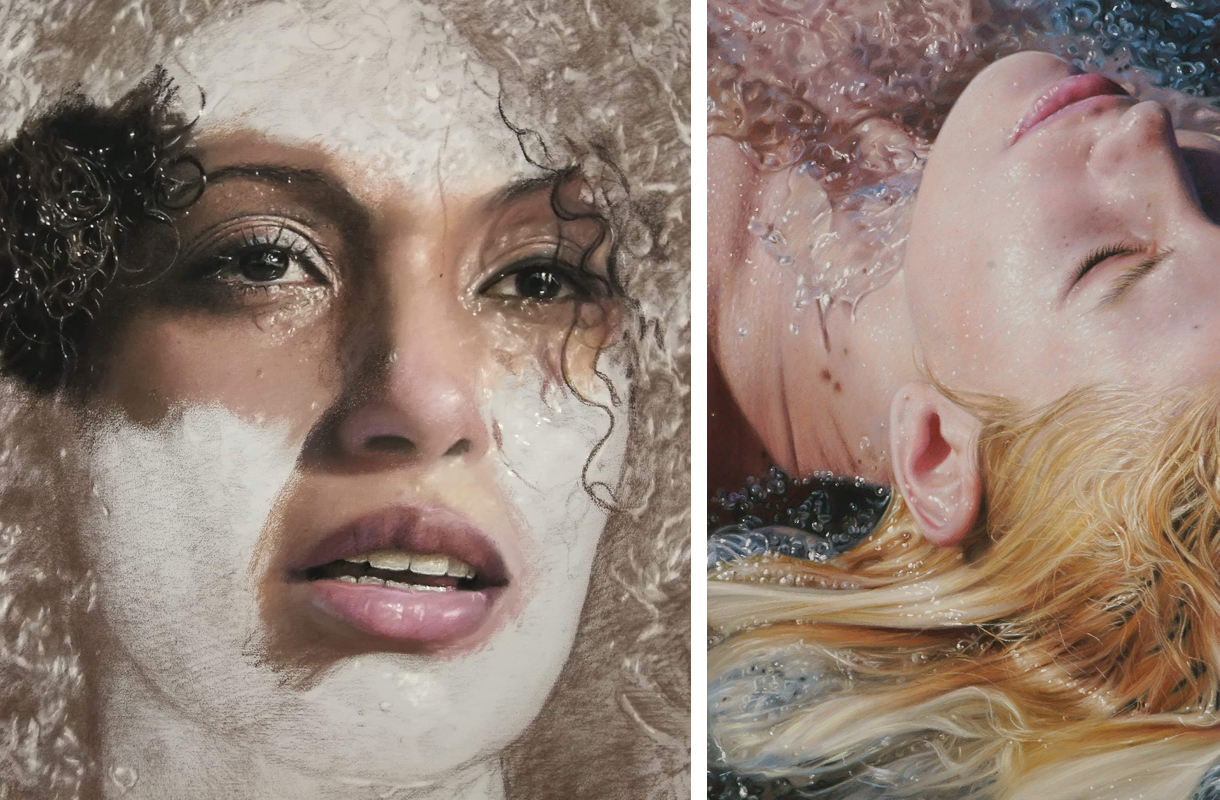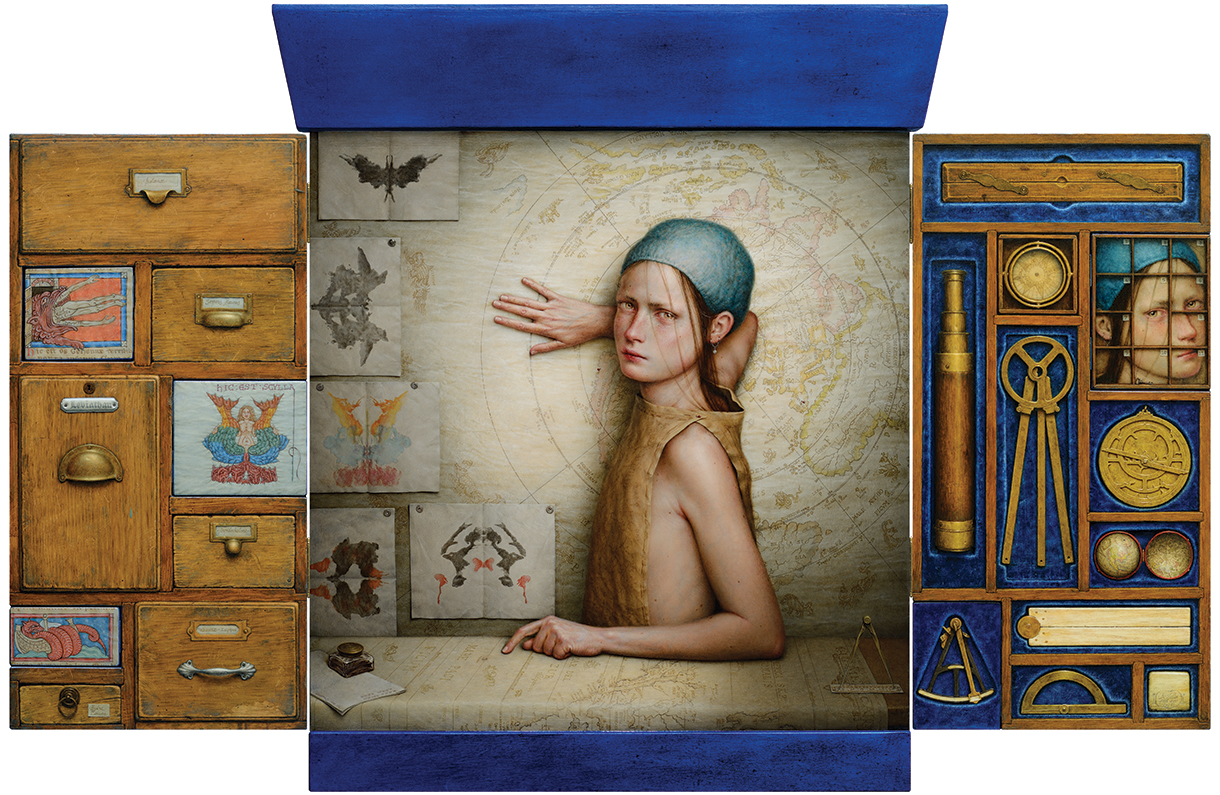
Detail: From Here, by classically trained artist Arantzazu Martinez. Born in 1977 in Vitoria, Alava, Spain, her permanent collection is on display at the European Museum of Modern Art in Barcelona. Courtesy Antonio Alba
The New Old Masters
Naturalistic paintings so real they could be mistaken for photographs.
Making a painting used to be a time-consuming activity. Extensive technical training was required, and the execution could take weeks, even years. The invention of photography in 1839 introduced a mechanical device that obviated the need for artists to replicate their subjects solely by hand and eye. Painters responded by making images that exploit the special possibilities of their medium, including its capacity to distort and abstract the visual world in personally expressive ways.
Yet admiration for the mastery of the Old Masters never died and some contemporary painters cater to that taste. They pursue their craft as they might have had they been born centuries earlier and rival the exquisite realism first achieved by Netherlandish artists in the 15th century. A patron of such mastery is Albrecht von Stetten, a German of aristocratic heritage who sold his family farm near Augsburg and partnered with East German agricultural concerns that, after the fall of the Berlin Wall and German unification, made him very wealthy. While looking for art to decorate his huge office, he made some studio visits. Von Stetten, who had considered an art career, asked one painter in Barcelona about his life as an artist and the painter confessed that it was awful, explaining that he had to earn a living making pictures that his gallery deemed saleable. Von Stetten offered to double his income for three months in exchange for the completed work of his dreams. The artist accepted, becoming the first benefactor of von Stetten’s revolutionary IBEX Collection (ibex-masters.com).
IBEX (an ibex features in the von Stetten family coat of arms) bills itself as “the largest active private collection of contemporary, figurative, Superrealist art.” Von Stetten, who favors naturalistic paintings, particularly those with brushstrokes so fine that they are indistinguishable within the illusory image, has scoured the globe for top practitioners. He offers the equivalent of a salary for however long is needed to realize the artist’s ideal figurative painting. The subject matter is entirely up to the artist, but the human figure is requisite, and IBEX takes ownership of the resulting painting. Von Stetten does not disclose exactly how many works are in the collection, but says that the number is in the hundreds.
Chief curator of the collection is Kiki Kim, the granddaughter of a Chinese calligrapher, whose art-world connections helped her organize a tour of hyperrealist artists in Asia. Her husband, David Willson, a brand marketing consultant, is executive director. They travel constantly in search of new talent and to visit masterworks in progress. They look for artists who can achieve maximum realism with the fewest perceptible brushstrokes. They even have a rating system.
“I want to be able to walk into a room where a painting from the collection is hanging and feel that the sitter is actually there,” von Stetten says.
Some of the paintings IBEX collects indeed achieve an eye-fooling verisimilitude. The artists’ technical abilities rival realist painters of any era. But, technical finesse and attention to detail are not always enough to elevate their subject matter, much of which showcases idealized youthful bodies and an abundance of female nudes and semi-nudes. Based on photographs, even the clothed figures can resemble outtakes from advertising shoots. Other works feature more freely invented figures in compositions designed to stimulate the mind, as well as the eye.
IBEX maintains a core collection of masterworks by 16 artists that they believe represent the crème de la crème of their holdings. Occasionally they mount short-term exhibitions that present the works to invited collectors, maintaining their goal to increase public awareness of the artists and of Superrealism within the art world. Shows have taken place in Singapore and Hong Kong, and a New York event is planned for 2020. Four such artists in Spain reveal their IBEX Masterpieces in progress, in advance of next year’s exhibition in Manhattan.

Sergio Martinez Cifuentes
Born in 1966, Concepcion, Chile; lives and works in Madrid.
An academic realist who has lived in Madrid for 19 years, Martinez Cifuentes paints ballerinas. These are not the scruffy “opera rats” that Edgar Degas recorded in casual moments, glimpsed from oblique angles and rendered with impressionist virtuosity. Martinez Cifuentes’ ballerinas are perfectly coiffed, perfectly fit beauties in rigid poses seen straight-on, often against empty backdrops. His study of the female body for the past two decades includes paintings of nudes sprawled on couches, seductively wrapped in delicate fabrics, or lying in the surf like the racy scene from the 1950s romance From Here to Eternity. The IBEX Masterpiece that Martinez Cifuentes is completing measures around 8 feet by 14 feet, his largest multi-figure work. The superbly realistic scene looks like an enlarged photograph of 10 actors in a modern palace or harem. He says the figures are based on cabaret artists whom he posed and photographed. He calls the painting Portrait of Desire, but the overriding feeling is of decadence and prurience.

Aurelio Rodríguez López
Born in 1958, Génave, Spain; lives and works in Estepona, Spain, southwest of Marbella.
Rodríguez López specializes in pastel and achieves remarkable naturalistic precision on a grand scale. His IBEX Masterpiece is a wood-panel triptych roughly 6 feet by 14 feet that depicts nearly life-size figures at the edge of the sea. Uniting the vignettes is a seascape and in the background the profile of Gibraltar and an African peninsula. The artist explains the iconography as an allegory of immigration to Europe, but his sunlit models’ flawless physical beauty conjures an ad for a gym or oceanside vacation rather than the reality of refugees risking death to better their lives.
Nevertheless, the work is a technical feat. It took 3.5 years for photo shoots, composing the composition on a computer, transferring key points onto the panels, and layering on pastel, smudging with his fingers and using edges of tiny shards to make fine marks while bracing his hand on a pinkie nail. Individual touches of the rendering are evident up close, but from afar he achieves impressive optical verisimilitude, drawing from an arsenal of more than 1,000 pastel bars and pencils.
Rodríguez López also paints and makes etchings, but he is most highly regarded for the hyperreal pastels he creates on an unmatched scale. He was awarded the International Association of Pastel Societies 2019 prize, and is in demand as a teacher in China where the medium is revered. He envisions exhibiting the triptych with sand on the floor in front of it, decorated with the same shells depicted in the piece.

Martin Llamedo
Born in 1980, Buenos Aires, Argentina; lives and works in Barcelona.
Llamedo studied painting, sculpture, and ceramics before immigrating to Spain in 2017, first to Madrid and then to Barcelona. He paints mainly women in settings imbued with a dreamlike atmosphere: a woman looking away out a tall casement window, a contemporary Pandora resting on a tile floor before a wooden casket, a ballerina in the nave of a cathedral radiating arms like a Shiva, a young woman and her doppelganger sitting back to back. His IBEX Masterpiece, a canvas about 7 square feet, presents another doubling. A woman and her clone stand behind a table set with a white, gauze-wrapped turkey; a vanilla cake made from foam and surgical gauze; a bowl of fabric-wrapped pears and pomegranates; and Champagne glasses filled with milk-like antiseptic Champagne. Llamedo digitally composed the image from multiple photographs, then painstakingly rendered the scene in oil with exquisite finesse.
As in many of his works, there is an eerie feeling of time suspended. The palette is leaden and the surface has a dusting of white pigment that lends a chill to the scene, an otherworldliness and tension echoed by the frozen stares of the women, who seem hypnotized or possessed, like automatons. Llamedo says that he intended to suggest a kind of dystopic American dream of domestic order, a condition that he believes may lie in the future.

Dino Valls
Born in 1959, Zaragoza, Spain; lives and works in Villanueva de la Cañada, northwest of Madrid.
Valls paints figures informed by his training as a doctor and presents them in allegorical compositions that reference art history and incorporate symbols that reflect his philosophical ideas. He has painted a young woman whose head is encased in an astrological device, a saint-like boy in a robe stained red with a map of his circulatory system, and a printer’s type box containing specimens including a butterfly, minerals, pigments, and the head of an alert girl on a velvet cloth.
His IBEX Masterpiece is a large triptych that evokes Northern Renaissance art. The panels are hinged like a medieval altarpiece, and a central predella shows a young woman partly immersed in a well with her hand resting on the head of a sickly child, submerged as if waiting to be born. Flanking the central panel are vignettes that depict cubbyhole-size rooms containing miscellaneous dramas and symbolic still lifes. The entire painting teems with symbolic texts, animal parts, skulls, scientific instruments, and flayed anatomical studies that suggest a Faustian cabinet of curiosities.
This piece is the artist’s summa, an effort to cram everything Valls knows into one grand work. The foreboding aspect reflects his concern that the health of the human species is threatened by hubris concerning technology and its capacity to transform the body. Even as we unpack the potential of genetic manipulation and biotechnology, we are merely animals and must proceed with caution: “The evolution of Homo sapiens could be ended by our own inventions,” he warns.
Valls is a talented draftsman but not a slave to realism and technique. He invents his imagery rather than working from photographs of models, and his painting is looser than that of other IBEX artists. His triptych is visually captivating, yet, even with an explanation of his ideas, his symbolic images remain arcane and only partly comprehensible. Nonetheless, the profusion of beautifully rendered and curious elements exudes the weirdness and unease of his warped vision, and rewards prolonged contemplation. As with all realist artists, the quality of the work is related directly to the quantity of hours invested in its making. The IBEX artists’ exhaustive methods are a direct affront to the often-slapdash images and objects rampant in today’s consumerist celebrity-driven market. The IBEX partners believe they are identifying and supporting the Old Masters of tomorrow, and at the very least, they have rewarded artists striving to perfect their craft.




